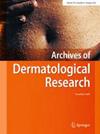Efficacy of intralesional pentoxifylline versus intralesional steroid versus intralesional vitamin D in treatment of keloid
Abstract
Several treatment modalities have been used for the treatment of keloid scarring but the optimal treatment has not yet been identified. Corticosteroids reduce excessive scarring by reducing collagen synthesis. Vitamin D can curb inflammation by inhibiting the activation and migration of leukocytes. Pentoxifylline is a methyl xanthine derivative initially developed for its vasodilatory properties. Evaluation and comparison between three modalities of treatment for keloid; intralesional vitamin D, pentoxifylline, and steroid. Forty-five patients with keloid lesions were divided into 3 groups; The first group: 15 patients were treated with intralesional triamcinolone acetonide. The second group: 15 patients treated with intralesional pentoxifylline. The third group: 15 patients treated with intralesional vitamin D. The response was evaluated clinically, Vancouver scar scale and patient satisfaction scale. At the end of the study, all groups showed highly statistically significant improvement compared to the baseline. The first group which was treated with triamcinolone acetonide showed excellent and good improvement 53% and 47% respectively. The second group which was treated with pentoxifylline showed excellent and good improvement 6.7% and 73.3% respectively. The third group which was treated with vitamin D showed excellent and good 6.7% and 86.7% respectively. Intralesional vitamin D and pentoxifylline are safe and effective therapeutic options for keloid lesions.

 求助内容:
求助内容: 应助结果提醒方式:
应助结果提醒方式:


